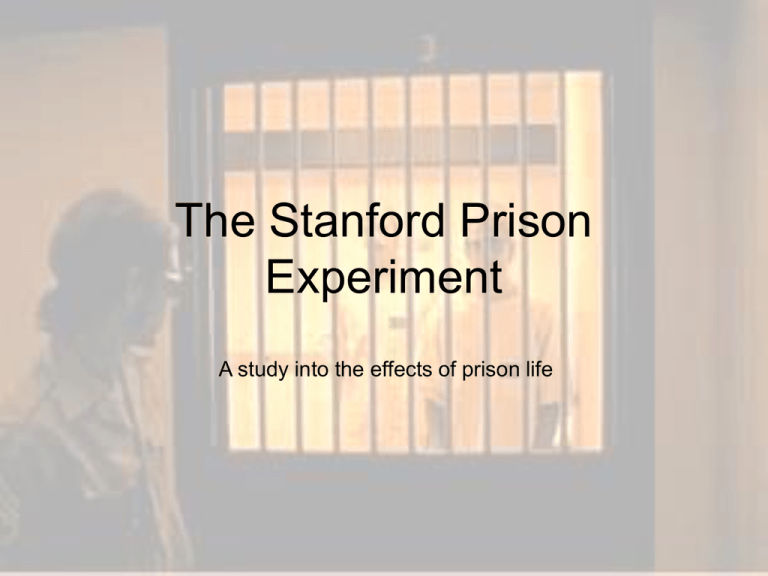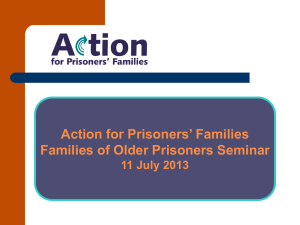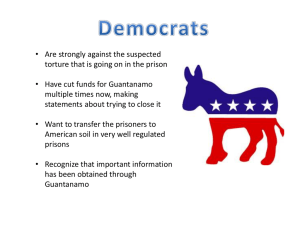- Simply Psychology
advertisement

The Stanford Prison Experiment A study into the effects of prison life Set-Up Volunteers: • Used volunteers to play the roles of guards and prisoners. • They had 24 final participants who were randomly assigned ‘guard’ or ‘prisoner’. • There was no difference between the two groups. Construction: • They had a consultant to create a realistic jail. He had spent roughly 17 years in prison. • The prison had a series of cells for three people, a closet for solitary confinement and a corridor. • There were no clocks or windows to show the time. • They had a video camera to record events and listened via an intercom. The Prisoners • The were arrested, read their rights and searched then taken to the police station. • At the station they were formally charged, fingerprinted, photographed and left blindfolded in a holding cell. • They were striped, deloused, supplied with a uniform. • The uniform was a smock with their ID number on it, a chain on their right ankles, and a stocking on their head. The Guards • They had complete freedom within reason to do what was necessary to maintain law and order. • They worn a uniform of kaki, they wore a whistle, carried a club and wore reflective sunglasses. • They were originally unsure of how to assert authority. • At first they used “counts” to do so. Rousing prisoners in the middle of the night. • There were 3 guards to the 9 prisoners, taking shifts of eight hours each. (the rest remained on call) Rebellion • The prisoners barricaded themselves in their cells. • The guards called in re-enforcements, and put the ringleaders in solitary, generally harassing the others. • As a longer term solution (they couldn’t keep all nine guards there) they set up a “privilege cell”. • The three least involved were allowed in there with clothes food and beds. • The solidarity of the prisoners had been broken and the ring leaders thought those in the “good cell” were snitches. The prisoners became mistrustful of each other. • The guards tightened their control over the prisoners, down to their use of the toilet. The First Release • Prisoner #8612 began suffering from acute emotional disturbance. • He wanted to leave but Zimbardo reacted like a prison governor. He offered him security if he became a snitch. • #8612 began spreading a message among the prisoners that it was real and they couldn’t leave. • The line between role play and reality became further blurred. • #8612 began to act “crazy” to the extent that Zimbardo released him. Escape • Guards heard rumors about a planned escape from the prisoners, released prisoner #8612 was going to come back and liberate them. • After several plans they moved the prisoners to another part of the building. Zimbardo waited for the liberators to come. • Instead he had a visit from a colleague and he realized that he was no longer acting like a psychologist but rather a governor. • The rumor turned out to be a rumor and the liberation never happened. • The guards took it out on the prisoners and stepped up their controls and harassment. Conclusions Prisoner Coping Styles: • • • • Some tried being good prisoners. Four broke down emotionally. Some tried rebelling against the guards. One developed a rash. The Final Rebellion: • • • • Prisoner #416 was newly admitted prisoner and coped by going on hunger strike. The guards put him in solitary confinement for longer than even their rules said. They offered the other prisoners a choice, they could get him free by giving up their blankets. They chose to keep them. he should have been a hero to them for standing up to the guards, but they saw him as the guards did; a trouble maker. Conclusions cont… Types of guard: • The tough but fair guards who followed prison rules. • The “good guys” who did little favors to the prisoners and never punished them. • The hostile and inventive in their humiliation. This included the toughest known as ‘John Wayne’. The Parole Board: • When asked prisoners were willing to forgo any money they made in order to leave the ‘jail’. • They did so even when they could have left simply by quitting the experiment. • It had become such that only the correctional staff had the power to grant paroles. The End of the Experiment The Experiment ended for two main reasons: • Guards were escalating their abuse. • Christina Maslach, a recent Stanford Ph.D questioned the morality of the study when she visited making it clear that it needed to be ended. After it ended they held a series of discussions with all the member to clear the air and discuss different experiences. Ethical Issues The key ethical issues that would have to be considered in both, Zimbardo’s original experiment and a repetitions of the experiment are: • Deception (and debriefing) • Consent • Protection from harm • Right to withdraw • Physical and psychological distress. Ultimately all this would have to be considered through a cost benefit analysis, weighing the results against the harm. Consent • “Whenever possible, the investigator should inform all participants of the objectives of the investigation.” Ps responded to an advertisement asking volunteers to take part in an experiment investigating ‘Psychological effects of prison life.’ • “The payment of participants must not be used to induce them to risk harm beyond that which they risk without payment in their normal lifestyle.” Paid $15 per day • Ps were given information about the study when they applied, and once chosen were asked to sign a consent form. • Were given fully informed consent about details of experiment. • Role-play situation meant that Zimbardo did not know how the Ps would react, so could not give precise details about what would happen during the experiment. When agreeing to participate, Ps (prisoners) would have realised that they would have:• Privacy violated. • Civil rights taken away • Minimally adequate diet Prisoners ‘rights’: • 3 meals per day, 3 supervised toilet trips, 2 hours for reading or letter writing, and 2 visiting periods per weeks. • Ps had line up 3 times a day to be counted and tested on the prison rules. Ps may not have been aware of the extent to which the experiment would be simulated. Many psychologists have argued that it is completely unacceptable to expose people to the degradation and hostility the participants experienced in the Stanford prison experiment, even if Zimbardo did gain the participants fully informed consent. Deception • The participants in the Zimbardo study were fully informed about what the study would show, so there was no deception. • There was no way of telling how serious the situation would get throughout the duration of the study. Debriefing• Zimbardo held day-long debriefing sessions. • Moral conflicts were discussed. • Most participants said that they had benefited from taking part in the study. •If a second experiment were conducted, the participants should be fully informed of the risks they are taking. •The first experiment gives us more of an idea of how much harm can come to the participants if they are not observed closely for signs of stress before the situation gets out of hand. Right to withdraw • Every participant who took part in the study had the right to withdraw. This was made clear. • One participant did withdraw from the experiment after just one day due to his severe symptoms of emotional disturbance. • However, The participants felt as though they didn’t have the right to withdraw, even when they went through the degradation and hostility that many ague were completely unethical. • If the experiment were to be repeated, the right to withdraw should be made as clear as possible. • Participants should be studied closely, and advised to leave if signs of stress that may lead to serious emotional disturbance. Protection from Harm Not very good - the participants suffered considerable distress during the study The experiment had to be cancelled after six days in order to protect the participants from each other: • The student-guards became quite sadistic, really getting into their roles. • The prisoners were also becoming quite mental. The prisoners especially suffered… • Prisoners exhibited rebellious behaviour • Guards retaliated - harassed, intimidated and used psychological tricks on the prisoners • They made them do degrading tasks • The humiliation and dehumanisation got so severe, that the experimenters had to frequently remind the guards to refrain from such tactics. Effects on the Prisoners The participants suffered form physical and psychological distress: • They started to experience acute emotional disturbance and rage. • They exhibited disorganized thinking, uncontrollable crying, withdrawing, and behaving in pathological ways. Critical views • Many critics such as Savin believed that the levels of degradation and hostility involved cannot be justified • Zimbardo himself admitted that it was unethical "because people suffered and others were allowed to inflict pain and humiliation on their fellows over an extended period of time." Cost-Benefit Analysis • • • • Study was of value because….. Illustrated affects of majority influence. Illustrated how the prison system operates. Showed that power of behaviour can have an effect on peoples behaviour “No one is ‘good’ or ‘bad’, but can be shaped to ‘good’ or ‘evil’.” Study is of value, but this does not justify the level of degradation and physical assault that the ‘prisoners’ experienced. Therefore any replication of the experiment would have to rectify this.








